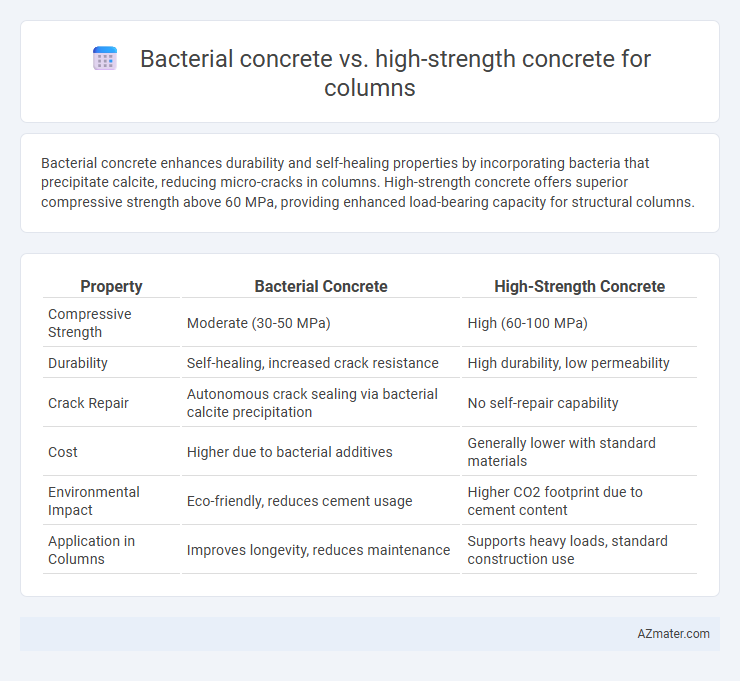Bacterial concrete enhances durability and self-healing properties by incorporating bacteria that precipitate calcite, reducing micro-cracks in columns. High-strength concrete offers superior compressive strength above 60 MPa, providing enhanced load-bearing capacity for structural columns.
Table of Comparison
| Property | Bacterial Concrete | High-Strength Concrete |
|---|---|---|
| Compressive Strength | Moderate (30-50 MPa) | High (60-100 MPa) |
| Durability | Self-healing, increased crack resistance | High durability, low permeability |
| Crack Repair | Autonomous crack sealing via bacterial calcite precipitation | No self-repair capability |
| Cost | Higher due to bacterial additives | Generally lower with standard materials |
| Environmental Impact | Eco-friendly, reduces cement usage | Higher CO2 footprint due to cement content |
| Application in Columns | Improves longevity, reduces maintenance | Supports heavy loads, standard construction use |
Introduction to Bacterial Concrete and High-Strength Concrete
Bacterial concrete incorporates microorganisms such as Bacillus pasteurii that precipitate calcium carbonate, enhancing crack healing and durability in structural columns, thereby extending service life and reducing maintenance costs. High-strength concrete, characterized by its compressive strength exceeding 40 MPa, is engineered using low water-to-cement ratios and supplementary cementitious materials to achieve superior load-bearing capacity in columns. Both technologies address structural resilience but differ in composition and performance optimization, with bacterial concrete emphasizing self-healing properties and high-strength concrete focusing on mechanical strength enhancement.
Composition and Formation Processes
Bacterial concrete incorporates specific microbial strains such as Bacillus pasteurii, which induce calcium carbonate precipitation within the matrix, enhancing self-healing properties and durability under stress. High-strength concrete typically consists of a refined mixture of cement, silica fume, and low water-to-cement ratio, achieving superior compressive strength through optimized particle packing and hydration reactions. The formation process of bacterial concrete involves bio-mineralization facilitated by bacterial metabolism, contrasting with the conventional chemical hydration and curing process utilized in high-strength concrete production.
Key Physical and Mechanical Properties
Bacterial concrete enhances self-healing capabilities by incorporating microbes that precipitate calcium carbonate, improving crack resistance and durability compared to high-strength concrete, which primarily relies on its dense matrix for strength. High-strength concrete exhibits superior compressive strength often exceeding 70 MPa, while bacterial concrete offers moderate strength with enhanced toughness and reduced permeability due to bio-precipitation. The modulus of elasticity in high-strength concrete is typically higher, providing greater stiffness, whereas bacterial concrete's improved microstructure contributes to better long-term durability and reduced maintenance for structural columns.
Durability and Longevity in Columns
Bacterial concrete enhances durability in columns by promoting self-healing of micro-cracks through microbial-induced calcite precipitation, significantly reducing permeability and delaying corrosion of steel reinforcement. High-strength concrete offers superior compressive strength and resistance to mechanical stress but may be prone to brittleness and micro-cracking under long-term loading conditions. For longevity in structural columns, bacterial concrete provides a sustainable advantage by extending service life through repeated crack repair and environmental resilience.
Crack Resistance and Self-Healing Capabilities
Bacterial concrete incorporates calcite-producing bacteria that significantly enhance crack resistance by autonomously filling microcracks, extending the durability of columns under stress. High-strength concrete, while offering superior compressive strength and load-bearing capacity, lacks intrinsic self-healing properties and relies on external repair methods for crack mitigation. The self-healing capabilities of bacterial concrete reduce maintenance costs and improve the long-term structural integrity of columns compared to conventional high-strength concrete.
Load-Bearing Capacity Comparison
Bacterial concrete enhances load-bearing capacity by promoting self-healing of micro-cracks and improving durability, which prolongs structural integrity under stress. High-strength concrete provides superior compressive strength due to its optimized mix design and low water-cement ratio, ideal for supporting heavy loads in columns. Comparative studies show bacterial concrete demonstrates improved long-term performance and crack resistance, while high-strength concrete excels in immediate load-bearing capacity with higher compressive strength values reaching 70 MPa or more.
Environmental Impact and Sustainability
Bacterial concrete significantly reduces carbon emissions by promoting self-healing properties that extend the lifespan of columns, minimizing the need for frequent repairs and reconstruction. High-strength concrete provides superior load-bearing capacity but involves higher cement content, leading to increased CO2 emissions and environmental degradation. Incorporating bacteria in concrete enhances sustainability by utilizing bio-mediated calcite precipitation, which reduces cracking and maintenance, making bacterial concrete an eco-friendlier alternative for column construction.
Cost Analysis and Economic Feasibility
Bacterial concrete offers a cost-effective alternative to high-strength concrete for columns by reducing repair and maintenance expenses through its self-healing properties, potentially lowering lifecycle costs despite higher initial material investments. High-strength concrete typically involves greater upfront costs due to specialized admixtures and production techniques but provides immediate structural benefits with established performance data. Economic feasibility favors bacterial concrete in long-term infrastructure projects where durability and sustainability reduce total expenditure over time.
Applications and Suitability for Structural Columns
Bacterial concrete excels in self-healing properties and durability, making it ideal for structural columns exposed to harsh environments or requiring enhanced longevity. High-strength concrete offers superior load-bearing capacity and is preferred for high-rise buildings and heavy-load columns where structural integrity is critical. Selecting between bacterial and high-strength concrete depends on project requirements such as environmental conditions, load demands, and maintenance considerations.
Challenges and Future Prospects
Bacterial concrete enhances self-healing and durability in columns but faces challenges like scalability, cost, and ensuring uniform bacterial distribution within high-strength matrices. High-strength concrete offers superior load-bearing capacity and stiffness, yet it is prone to brittleness and requires precise mix designs to avoid micro-cracking under stress. Future prospects involve integrating microbial technology with advanced composite additives to develop sustainable, resilient columns that balance strength and self-repair capabilities.

Infographic: Bacterial concrete vs High-strength concrete for Column
 azmater.com
azmater.com